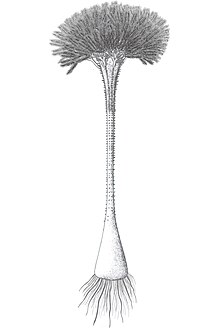Content deleted Content added
possible synonymy |
more |
||
| Line 17: | Line 17: | ||
'''''Calamophyton''''' is an extinct [[genus]] of tree, or "tree-sized plant",<ref>{{cite web |last1=Giesen |first1=Peter |last2=Berry |first2=Christopher M. |title=Reconstruction and Growth of the Early Tree Calamophyton (Pseudosporochnales, Cladoxylopsida) Based on Exceptionally Complete Specimens from Lindlar, Germany (Mid-Devonian): Organic Connection of Calamophyton Branches and Duisbergia Trunks |url=https://www.journals.uchicago.edu/doi/abs/10.1086/669913 |website=The University of Chicago Press Journals |publisher=University of Chicago |access-date=17 March 2024 |doi=10.1086/669913}}</ref> that was extant in the Middle [[Devonian]] period. ''Calamophyton'' trees formed the earliest known forests.<ref>{{cite news |last1=Devlin |first1=Hannah |title=World’s oldest fossilised trees discovered along Devon and Somerset coast |url=https://www.theguardian.com/science/2024/mar/06/worlds-oldest-fossilised-trees-discovered-along-devon-and-somerset-coast |access-date=17 March 2024 |work=The Guardian |publisher=Guardian News & Media Limited |date=7 March 2024}}</ref> |
'''''Calamophyton''''' is an extinct [[genus]] of tree, or "tree-sized plant",<ref>{{cite web |last1=Giesen |first1=Peter |last2=Berry |first2=Christopher M. |title=Reconstruction and Growth of the Early Tree Calamophyton (Pseudosporochnales, Cladoxylopsida) Based on Exceptionally Complete Specimens from Lindlar, Germany (Mid-Devonian): Organic Connection of Calamophyton Branches and Duisbergia Trunks |url=https://www.journals.uchicago.edu/doi/abs/10.1086/669913 |website=The University of Chicago Press Journals |publisher=University of Chicago |access-date=17 March 2024 |doi=10.1086/669913}}</ref> that was extant in the Middle [[Devonian]] period. ''Calamophyton'' trees formed the earliest known forests.<ref>{{cite news |last1=Devlin |first1=Hannah |title=World’s oldest fossilised trees discovered along Devon and Somerset coast |url=https://www.theguardian.com/science/2024/mar/06/worlds-oldest-fossilised-trees-discovered-along-devon-and-somerset-coast |access-date=17 March 2024 |work=The Guardian |publisher=Guardian News & Media Limited |date=7 March 2024}}</ref> |
||
The genus was established in 1926 from specimens collected by R. Kräusel & H. Weyland, in Hardberg and Kirberg, [[Rhineland]], Germany, who identified the [[type species]] ''C. primaevum''.<ref name="leclerc_andrews_feb1960_pp1-2">{{cite journal |last1=Leclercq |first1=Suzanne |last2=Andrews |first2=Henry N. Jr. |title=Calamophyton bicephalum, a New Species from the Middle Devonian of Belgium |journal=Annals of the Missouri Botanical Garden |date=Feb 1960 |volume=47 |issue=1 |page=2 |doi=10.2307/2394614 |url=https://www-jstor-org.wikipedialibrary.idm.oclc.org/stable/2394614}}</ref> A second species, ''C. renierii'', was identified by S. Leclercq in [[Belgium]] in 1940, |
The genus was established in 1926 from specimens collected by R. Kräusel & H. Weyland, in Hardberg and Kirberg, [[Rhineland]], Germany, who identified the [[type species]] ''C. primaevum''.<ref name="leclerc_andrews_feb1960_pp1-2">{{cite journal |last1=Leclercq |first1=Suzanne |last2=Andrews |first2=Henry N. Jr. |title=Calamophyton bicephalum, a New Species from the Middle Devonian of Belgium |journal=Annals of the Missouri Botanical Garden |date=Feb 1960 |volume=47 |issue=1 |page=2 |doi=10.2307/2394614 |url=https://www-jstor-org.wikipedialibrary.idm.oclc.org/stable/2394614}}</ref> A second species, ''C. renierii'', was identified by S. Leclercq in [[Belgium]] in 1940, a third, ''C. bicephalum'', also in Belgium, by Leclerqc and H. Andrews in 1960,<ref name="leclerc_andrews_feb1960_pp1-2"/> and a fourth, ''C. forbesii'', in [[Maine]], United States, by James M. Schopf in 1964. It has since been suggested that ''C. primaevum'' and ''C. bicephalum'' may be the same species. |
||
== References == |
== References == |
||
{{reflist}} |
{{reflist}} |
||
Revision as of 02:45, 18 March 2024
| Calamophyton Temporal range: Middle Devonian
| |
|---|---|

| |
| Scientific classification | |
| Kingdom: | Plantae |
| Clade: | Tracheophytes |
| Division: | Pteridophyta (?) |
| Class: | †Cladoxylopsida |
| Order: | †Pseudosporochnales |
| Family: | †Hyeniaceae |
| Genus: | †Calamophyton R.Kräusel & H.Weyland, 1925 |
| Species | |
| |
Calamophyton is an extinct genus of tree, or "tree-sized plant",[1] that was extant in the Middle Devonian period. Calamophyton trees formed the earliest known forests.[2]
The genus was established in 1926 from specimens collected by R. Kräusel & H. Weyland, in Hardberg and Kirberg, Rhineland, Germany, who identified the type species C. primaevum.[3] A second species, C. renierii, was identified by S. Leclercq in Belgium in 1940, a third, C. bicephalum, also in Belgium, by Leclerqc and H. Andrews in 1960,[3] and a fourth, C. forbesii, in Maine, United States, by James M. Schopf in 1964. It has since been suggested that C. primaevum and C. bicephalum may be the same species.
References
- ^ Giesen, Peter; Berry, Christopher M. "Reconstruction and Growth of the Early Tree Calamophyton (Pseudosporochnales, Cladoxylopsida) Based on Exceptionally Complete Specimens from Lindlar, Germany (Mid-Devonian): Organic Connection of Calamophyton Branches and Duisbergia Trunks". The University of Chicago Press Journals. University of Chicago. doi:10.1086/669913. Retrieved 17 March 2024.
- ^ Devlin, Hannah (7 March 2024). "World's oldest fossilised trees discovered along Devon and Somerset coast". The Guardian. Guardian News & Media Limited. Retrieved 17 March 2024.
- ^ a b Leclercq, Suzanne; Andrews, Henry N. Jr. (Feb 1960). "Calamophyton bicephalum, a New Species from the Middle Devonian of Belgium". Annals of the Missouri Botanical Garden. 47 (1): 2. doi:10.2307/2394614.